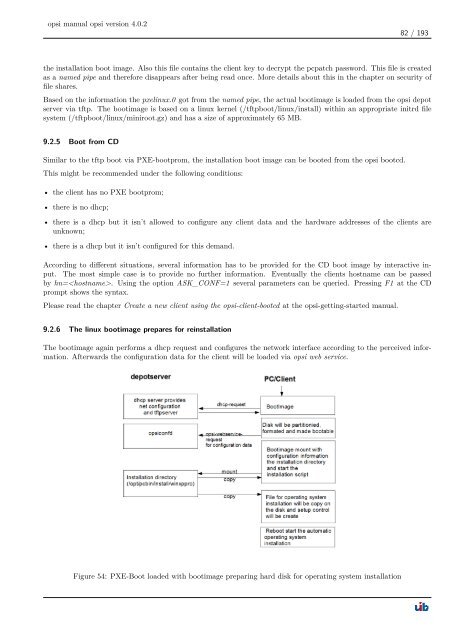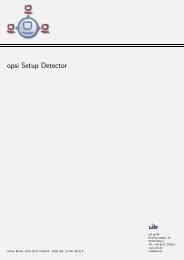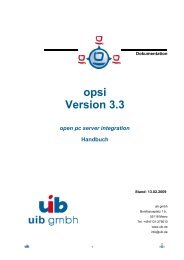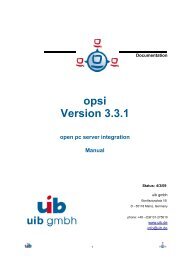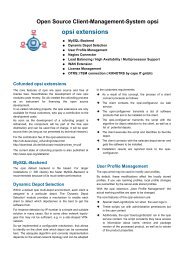opsi manual opsi version 4.0.2 - opsi Download - uib
opsi manual opsi version 4.0.2 - opsi Download - uib
opsi manual opsi version 4.0.2 - opsi Download - uib
Create successful ePaper yourself
Turn your PDF publications into a flip-book with our unique Google optimized e-Paper software.
<strong>opsi</strong> <strong>manual</strong> <strong>opsi</strong> <strong>version</strong> <strong>4.0.2</strong><br />
82 / 193<br />
the installation boot image. Also this file contains the client key to decrypt the pcpatch password. This file is created<br />
as a named pipe and therefore disappears after being read once. More details about this in the chapter on security of<br />
file shares.<br />
Based on the information the pxelinux.0 got from the named pipe, the actual bootimage is loaded from the <strong>opsi</strong> depot<br />
server via tftp. The bootimage is based on a linux kernel (/tftpboot/linux/install) within an appropriate initrd file<br />
system (/tftpboot/linux/miniroot.gz) and has a size of approximately 65 MB.<br />
9.2.5 Boot from CD<br />
Similar to the tftp boot via PXE-bootprom, the installation boot image can be booted from the <strong>opsi</strong> bootcd.<br />
This might be recommended under the following conditions:<br />
• the client has no PXE bootprom;<br />
• there is no dhcp;<br />
• there is a dhcp but it isn’t allowed to configure any client data and the hardware addresses of the clients are<br />
unknown;<br />
• there is a dhcp but it isn’t configured for this demand.<br />
According to different situations, several information has to be provided for the CD boot image by interactive input.<br />
The most simple case is to provide no further information. Eventually the clients hostname can be passed<br />
by hn=. Using the option ASK_CONF=1 several parameters can be queried. Pressing F1 at the CD<br />
prompt shows the syntax.<br />
Please read the chapter Create a new client using the <strong>opsi</strong>-client-bootcd at the <strong>opsi</strong>-getting-started <strong>manual</strong>.<br />
9.2.6 The linux bootimage prepares for reinstallation<br />
The bootimage again performs a dhcp request and configures the network interface according to the perceived information.<br />
Afterwards the configuration data for the client will be loaded via <strong>opsi</strong> web service.<br />
Figure 54: PXE-Boot loaded with bootimage preparing hard disk for operating system installation


